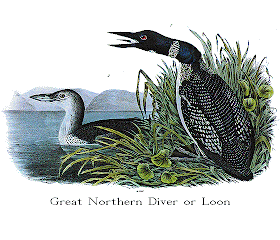







My Dad dropped an intriguing nugget of knowledge in conversation yesterday, which I confirmed last night so I could bring it to you today. French-American naturalist John James Audubon (1785-1851) tasted almost all of the birds he so beautifully drew. It shouldn't be so surprising, given that they were a viable food source, he was going to kill them anyway, and he was on the trail for months at a time. As one website explains, "Audubon's life was tinged with irony. Naming himself 'the American Woodsman,' he anticipated the practice of placing rings on birds' legs to track their movement, marking nestlings with 'a light silver thread' and checking on them a year later. He often lamented the quick destruction of the wild — so much that he has become an example for modern conservationists. Yet to paint realistic pictures, he had to shoot hundreds of birds. Because he worked in the wilderness for long stretches with no other food source, he had to eat those birds, too." Biographer Richard Rhodes adds, "There weren’t any cameras in the early 19th century, nor any binoculars. To draw a bird you had to shoot it. He shot, collected, mounted and drew. After he drew he dissected, investigating the birds’ anatomy and what they ate. Sometimes he shot multiple specimens to determine the type and preserved the skins for museums. And then, since he was out in the wilderness for weeks at a time collecting and drawing, he almost always cooked and ate his catch–which gives an idea of how quickly he could do a drawing. People today don’t realize that wild birds, including songbirds, were considered a valuable food resource in Audubon’s day and were shot in great numbers for sale in local markets, much as wild fish are harvested today."
Audubon (pictured in 1826 with his gun) left his critiques of the taste of various birds (images above), which I have collected from biographies and his journal entries. Of the great blue heron, he writes, "Young birds from the nest afford tolerable eating; but the flesh of the old birds is by no means to my taste, nor so good as some epicures would have us to believe, and I would at any time prefer that of a Crow or young Eagle." "Their flesh is dark, generally tough, and has a rank fishy taste," is his comment on the flavor of the Florida cormorant. The wood thrush was "delicate and juicy," and, for some, the loon was best "served almost raw." A diary entry in October 1820 read, "Grebes were cooked and eat but extremely Fishy rancid and fat-," and the following month he wrote, "I eat the purple grakle it tasted well-." He says nothing of the young turkey, killed within 20 miles of Washington, that he shared at the table of President Andrew Jackson.
Since I once made a visit to the zoo specifically to look at the animals Frank Buckland sampled, I would say that knowing this information will cause me to look at Audubon's engravings with even more interest.
It's not surprising that he ate the birds. Today we tend to attribute a modern mindset to people who lived in past centuries. It's hard to put oneself in their place and think as they must have. Since he had to shoot the birds to be able to draw them, then by eating them he wasn't wasting anything, and certainly not just hunting for sport. Anyway,his drawings are beautiful. Thanks for the link, some great inspiration there!
ReplyDelete